MONTE CASSINO ABBEY ORDERED DESTROYED
Cassino, Italy · February 15, 1944
On this date in 1944 Gen. Harold Alexander, commander-in-chief of all Allied forces in the Mediterranean Theater, ordered the aerial bombing of the historic Benedictine abbey towering over the town of Cassino on the banks of the Rapido (Gari) River in Italy. Earlier in January British, American, and French troops had made a series of attacks on the main German defenses in mainland Italy, the Gustav Line—this around the town of Cassino (red line on map below). Sometimes called the First Battle of Cassino, these attacks produced only limited gains.
The bombing of the iconic fortress-like abbey, which Alexander wrongly thought was being used by the Germans as an observation post, was part of a broader effort by soldiers from ten Allied nations and territories to break through the German lines and open one of only two roads connecting Southern Italy, in Allied hands, and German-held Rome, Italy’s capital. Monte Cassino’s destruction, Alexander admitted later, was “necessary more for the effect it would have on the morale of the attackers than for purely material reasons.”
Surprisingly, a full day passed before the initial air strike by 229 heavy and medium bombers, dropping 1,150 tons of high explosives and incendiary bombs on the abbey, was followed up by attacks on the ground. By then the Germans had time to convert the ruins and the thick-walled foundations of the monastery into an impregnable stronghold from which they could direct deadly artillery fire against anyone sent against them.
More air and ground assaults would take place before the Allies, after suffering approximately 55,000 casualties (the Germans incurred at least 20,000 casualties), were able to raise their flag—an improvised Polish regimental flag—over the rubble of the abbey on May 18, 1944, as well as over 30 wounded soldiers left by their comrades as the Germans abandoned the western half of the Gustav Line for new defensive positions along the Adolf Hitler Line (green line on map).
![]()
The Historic Hilltop Abbey of Monte Cassino, Founded in AD 529 by St. Benedict of Nursia
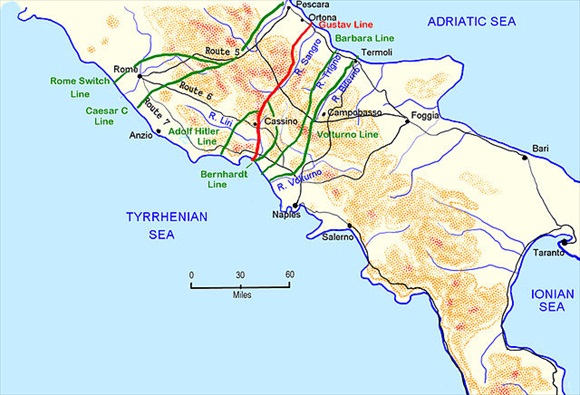 |
Above: German-prepared defensive lines stretched across the Italian peninsula south of Rome, 1943–1944. The primary line was the Gustav Line (red line on map), often called the Winter Line, centered on the town of Cassino. High above Cassino was the medieval Benedictine abbey of Monte Cassino, which dominated the entrance to the Liri River Valley, one of two main routes to Rome, roughly 90 miles away. Adolf Hitler had ordered the Gustav Line defended “in a spirit of holy hatred not only against the enemy, but against all officers and units who fail in this decisive hour.”
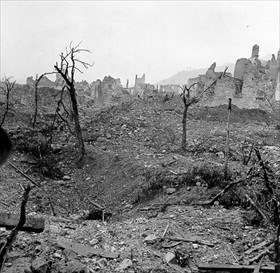 | 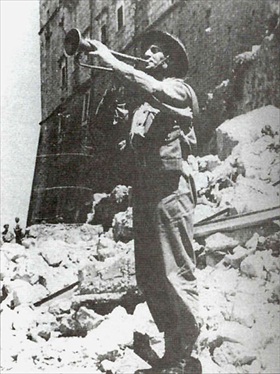 |
Left: Ruins of the town of Cassino after the hellish four-month battle. In the background are the ruins of the Abbey of Monte Cassino. The abbey lay just over one mile to the west of the town at an elevation of 1,700 ft and had a commanding view of the Liri and Rapido valleys, Allied gateways to German-held Rome. The four battles to take the town and abbey cost the lives of more than 14,000 men from a dozen nations. Total Allied casualties spanning the period of the four Cassino battles and the Anzio campaign with the subsequent capture of Rome on June 5, 1944, were over 105,000.
![]()
Right: A Polish bugler plays the traditional five-note Polish anthem, the Hejnał Mariacki (also called the Kraków Anthem), at the foot of Monte Cassino Abbey, announcing the Allied victory on May 18, 1944. Elements of the Polish II Corps were the first among the Allied units to reach Monte Cassino’s summit.
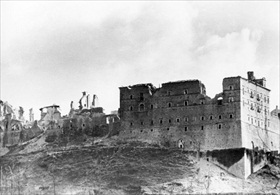 | 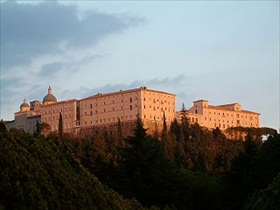 |
Left: Monte Cassino in ruins, February 1944. St. Benedict of Nursia established his first monastery, the source of the Benedictine Order, here around AD 529 and over time it become a repository of valuable art works and a world-renowned library. The controversial and tragic destruction of the abbey, fortunately empty of its movable art and world-renowned library, and the death of more than one hundred Italian refugees who had sought sanctuary within its walls were a huge propaganda coup for the Nazis, and Minister of Public Enlightenment and Propaganda Joseph Goebbels played up the destruction and deaths for all their worth.
![]()
Right: The restored Abbey of Monte Cassino sits on rocky hill some 90 miles southeast of Rome. It is still one of the most famous monasteries in Christendom.
The Hellish Battle for Monte Cassino, Italy, January–May 1944
![]()

 History buffs, there is good news! The Daily Chronicles of World War II is now available as an ebook for $4.99 on Amazon.com. Containing a year’s worth of dated entries from this website, the ebook brings the story of this tumultuous era to life in a compelling, authoritative, and succinct manner. Featuring inventive navigation aids, the ebook enables readers to instantly move forward or backward by month and date to different dated entries. Simple and elegant! Click
History buffs, there is good news! The Daily Chronicles of World War II is now available as an ebook for $4.99 on Amazon.com. Containing a year’s worth of dated entries from this website, the ebook brings the story of this tumultuous era to life in a compelling, authoritative, and succinct manner. Featuring inventive navigation aids, the ebook enables readers to instantly move forward or backward by month and date to different dated entries. Simple and elegant! Click 











